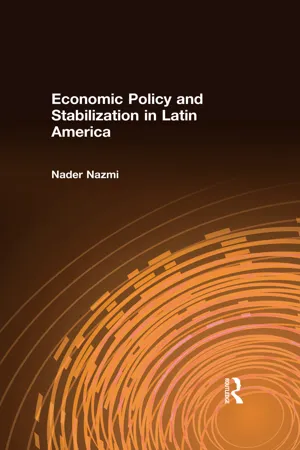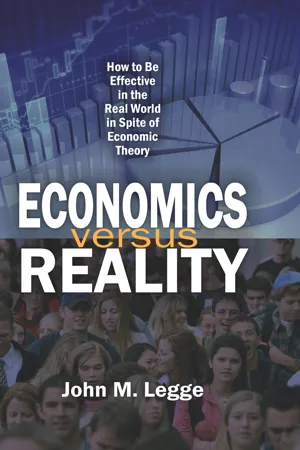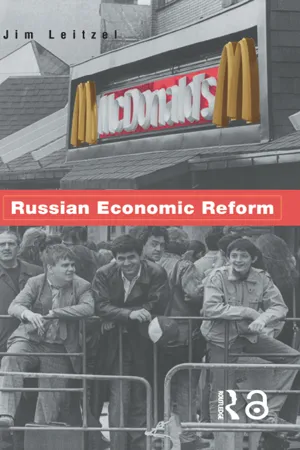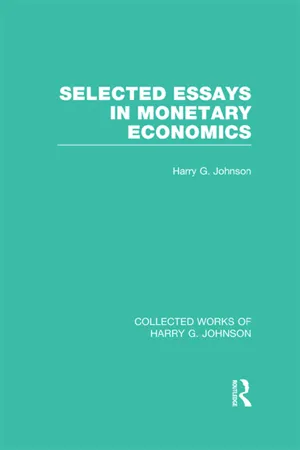Economics
Costs of Inflation
The costs of inflation refer to the negative impacts that rising prices can have on an economy. These costs include reduced purchasing power, uncertainty for businesses and consumers, and distortions in the allocation of resources. Inflation can also lead to higher interest rates and reduced real returns on savings and investments.
Written by Perlego with AI-assistance
Related key terms
7 Key excerpts on "Costs of Inflation"
- eBook - ePub
- Samih Atef El-Zeyn(Author)
- 2019(Publication Date)
- Routledge(Publisher)
How can these effects be illustrated?Woe unto a country in which inflation exists and controls this country’s resources. Woe unto the people of this country and the bad effects on their incomes, their exchanges with other countries and their economic growth.1. Effect of Inflation on Incomes
Inflation has a great effect on incomes as it leads to adjustments in the incomes of the various working segments of the society. This is because incomes increase nominally due to the increase in wages as a result of the demands of trade unions in particular and the various social units in general, the reason being to balance their incomes with prevailing prices. This increase in wages is not linked to the rates or indicators of increases in the price of merchandise and services, which go up at a rate that swallows up any increase in wages.141 (p. 310) In many instances, the increase in prices is at a rate higher than any increase in wages which causes incomes to lose a portion of their purchasing power. The effects of this increase will have a negative reflection on people of limited income in the poor and middle classes.If the annual rate of inflation exceeds 3 per cent, which is the relatively normal and acceptable rate, the existence of three classes in the society (poor, middle and rich, for example) will be affected to the extent that the middle class will dissolve into the lower class. Conversely, the rich become richer with increase of their capital attributed to one basic reason, namely the control this class has over the various economic sectors or over the main and most important sectors of the economy of the country. This is due to the excessive profits they gain, whether through the increase in the price of products available, prices which are higher than cost of production, or through the assitance they obtain from the State under the pretext of protecting national production and strengthening the basis of the economy. - eBook - ePub
- Thomas Crump(Author)
- 2011(Publication Date)
- Routledge(Publisher)
This explains why ‘cost-push’, which is the alternative to ‘demand-pull’ inflation, is much easier to live with. In any sector to which it applies, it means that the prices of outputs have to be increased ‘defensively’, simply because of the increased cost of inputs—such as labour, or imported raw materials (Flemming, 1976, p. 12). Everything is blamed on the trade unions, or on the OPEC lands (particularly those whose religion is Islam). This latter case has the advantage of being able to show that the inflation is triggered off from outside the sphere of payment, allowing the authorities to adopt a convenient air of injured innocence.In considering the causes of inflation one is confronted with a vicious circle. There are quite logical arguments to prove that neither ‘cost-push’ nor ‘demand-pull’ can be a cause of inflation (Machlup, 1969, pp. 151f.). Inflation is in fact a vicious circle, and ‘demand-pull’ and ‘cost-push’ are little more than two sides of the same coin. So also, once inflation is started, is it difficult to distinguish between cause and effect, a point to be borne in mind in the following section.The consequences of inflation
The consequences of inflation are twofold: the redistribution of purchasing power and the revaluation of assets and liabilities. As to the first, each separate sector in the economic complex sees its money income increased at different stages in the inflationary cycle. For every such sector two factors are critical: the first is the amount of the increase accruing to it; the second, the time at which it occurs. The significance of the first factor may be evaluated in terms of the share of the sector concerned in the aggregate flow of money—MV in Fisher’s equation. The immediate result of an increase in the income accruing will be to increase this share, and although this must lead to a decrease in the share of other sectors, this need involve no loss in real terms so long as it corresponds to a rateable increase in productivity. That is, an increase in MV is not inflationary, so long as it leads only to an increase in T, with P remaining unchanged. If, however, this does not happen (which is the general case), the increase in P - Nader Nazmi(Author)
- 2016(Publication Date)
- Routledge(Publisher)
The inertialists assume that the practice of markup pricing, caused by the oligopolistic nature of production in Brazil, is one of institutional factors responsible for the inertial nature of Brazilian inflation. In the environment of high inflation, it is easy to misconstrue markup pricing, which is a symptom of high inflation, as a cause of inflation. As discussed above, higher inflation is suspected of causing increased relative price variability and price uncertainty. To protect themselves from losses from inflation, producers may resort to markup pricing that adjusts their prices for previous-period inflation as well as expected inflation. This can happen even in highly competitive markets because for consumers the cost of obtaining information about various vendors' prices becomes very high.We concluded that inflation can have welfare, redistributive and disruptive impacts on the economy. Recent studies indicate that the welfare cost of high inflation is perhaps much higher than indicated by earlier studies. For Brazil, some estimates of the welfare cost of inflation exceed 50 percent of GDP. The redistributive effect of inflation works at income and wealth levels. The redistribution effect on the income level depends greatly on the source of inflation. For the Brazilian case, a recent study concluded that inflation worsened income inequality by redistributing income in favor of upper-income groups, mostly by squeezing middle-income groups. The wealth effect of inflation is more straightforward, as it always benefits net borrowers at the expense of net lenders. Finally, the disruptive impact of inflation results from efficiency losses. Higher inflation rates result in more general price and relative price variability and thus make it more difficult to make decisions based on prices. As the role of prices as a signaling mechanism for economic decision making is hindered, economic efficiency is reduced.Some authors have argued convincingly that the evils of inflation are often brought about by governments eager to eradicate them. In other words, deflation policies introduced by governments are likely to prove more costly to the society than inflation itself. In these situations, inflation costs the economy indirectly through government policies. As we examine in chapter 2- eBook - ePub
Economics versus Reality
How to be Effective in the Real World in Spite of Economic Theory
- John Legge(Author)
- 2017(Publication Date)
- Routledge(Publisher)
6Inflation
Inflation occurs when the average prices of consumption goods and services rise without corresponding quality increases. Inflation has occurred at many times and for many reasons.A steady rate of monetary growth at a moderate level can provide a framework under which a country can have little inflation and much growth.— Milton FriedmanIn Chapter 4 above, I mentioned that economists generally find money an elusive concept, and so inflation becomes elusive squared. If money is a mere lubricant making barter easier, then the amount of it available, and the price of any individual item offered for sale, are second-order issues of no great importance. Keynes attempted to break this fixation with barter by focusing on the difference between the real wage (an arbitrary amount of money that suffices to buy a given basket of goods) and the money wage (a definite amount of money that may or may not suffice to buy the same basket of goods).Keynes noted that wages are nearly always defined in terms of money; payment in goods (“truck”) is actually illegal in Britain and other common-law countries, and has been since the early nineteenth century. Wages are, of course, the employer’s costs: and if prices rise while money wages do not, employers earn greater profits; conversely, if prices fall but money wages do not, employers will earn reduced profits and may even be forced into a loss. Keynes, and Irving Fisher before him, noted that loan contracts are practically always designated in money terms, and so employers who finance their business in whole or in part with borrowed money suffer a double squeeze if prices fall as a fixed amount of interest must be paid out of a diminished gross profit. - eBook - ePub
- James Leitzel(Author)
- 2005(Publication Date)
- Routledge(Publisher)
150 The information is still there, but it requires more effort to ferret out and process. Lives are less quiet.The variability of inflation rates and the different timing of price increases among goods and services is the source of another cost that can be attributed to open inflation. As Western economist Rudiger Dornbusch has noted, ‘An environment of high and unstable inflation deters productive economic activity.… Spurious gains and losses related to the vagaries of inflation rather than to effort and productivity become the rule.’151 Why bother to work hard when the return you receive depends more on something outside your control—the ‘vagaries of inflation’—than on your labour input? Investment, then, can be undermined by persistent inflation, hindering long-run economic growth.152There is one more important cost associated with open inflation in a market economy, and that is the cost of reversing the inflationary process. Nothing in inflation is more unbecoming than the leaving it. Substantial reductions in inflation in market economies are generally accompanied by a recession. The costs of recessions, with their reductions in output and their increased unemployment, are quite high. It is estimated that the cost of a reduction in the US inflation rate of one per cent requires a four per cent reduction in one year’s output.153 For a meagre one per cent reduction in the inflation rate, our country, by this calculation, must pay a sum that is currently equal to nearly $230 billion.COSTS OF REPRESSED INFLATIONIn contrast to open inflation, repressed inflation takes various forms, all of which were present in the pre-reform Russian economy. These forms include: (1) lessened availability of goods in the state (fixed-price) sector, (2) longer queues when goods are available in the state stores; (3) deterioration in the quality of state-sector goods; (4) disappearance of low-priced varieties of the output assortment in the state stores; and (5) higher prices (i.e., open inflation) in the parallel, free markets. Lowering the quality of a good while maintaining the same fixed price (repressed inflation (3)) represents a hidden price increase. Getting rid of low-price varieties (4), for example, by representing a product that is only marginally changed as an ‘improvement’ and therefore deserving of a higher fixed price, is another form of hidden price increase. Along with the open inflation in the free markets (5), these varieties of hidden price rises are not uncommon in Western market economies. - Harry Johnson(Author)
- 2013(Publication Date)
- Routledge(Publisher)
The quantity theory approach to inflation, which views inflation as imposing a tax on holdings of real balances, has some definite implications that are in contrast with those of the Keynesian approach discussed in the previous section. In the first place, the redistribution of income involved in inflation is not primarily a redistribution among income groups, but a redistribution from the holders of cash balances to, in the first instance at least, the controllers of the money supply; in other words it is a redistribution from the community at large in its capacity as a holder and user of money to the monetary authority, not from one group of participants in the distribution of the national income to another. In the second place, the rate of inflation is determined, once inflation becomes established, by the rate of increase of the money supply rather than by the institutional factors governing the responses of wages and prices to one another—the institutional factors are assumed, or predicted, to adapt themselves to the rate of inflation. In the initial phase of inflation, however, the rate of inflation is likely to be less than the rate of increase of the money supply owing to the persistence of belief in the stability of prices, and thereafter for a period the rate of inflation is likely to exceed the rate of increase of the money supply owing to the effects of growing belief in the continuance of inflation in reducing the demand for real balances.FIGURE 1In the third place, the cost of inflation appears, not as a socially undesirable redistribution of income—since the owners of wealth, once they become accustomed to the fact of inflation, will incorporate the rate of inflation in the money rate of interest on loans fixed in money terms—but as the waste of resources involved in the effort of the public to economize on the use of money by substituting real resources for it. Such substitution, which may take such forms as shortening the intervals between wage payments, holding stocks of goods instead of money, and so forth, will be carried to the point where the alternative rate of return on the real resources substituted for the use of money is equal to the rate of inflation. In Figure 1 , the cost of inflation to the economy is measurable by the area P′MD′, and can be approximated by the formula 1/2 Ṗ η, where Ṗ is the rate of inflation, is the ratio of money to income held at the given rate of inflation, and η is the inflation-elasticity of the ratio of money to income. (In a more elaborate analysis, it would be necessary to recognize that the fact that interest is not paid on cash balances implies a social loss from the substitution of real resources for money in the absence of inflation, a loss aggravated by the effect of inflation in discouraging the use of money.) Finally, the notion of inflation as a tax, and of the cost of inflation as a sort of ‘collection cost’ of this tax, implies certain analogies between inflation and the more explicit taxes levied by the government, including the concept of the optimum rate of inflation from the point of view of the government, that is, the rate of inflation that maximizes the proportion of national income put at the government’s disposal by inflation; these analogies have been developed by Martin J. Bailey in an important article on the welfare cost of inflationary finance.1- eBook - ePub
- Jakob De Haan(Author)
- 2012(Publication Date)
- Routledge(Publisher)
Measurement issues in the consumer price index are discussed in Section 4.2. Section 4.3 presents empirical evidence on the sacrifice ratio of disinflation policies. Section 4.4 turns to the benefits of price stability: we estimate the effects of inflation on consumption allocation, housing demand, money demand and government debt service. For a permanent reduction of inflation by 2 percentage points (from 2 per cent to zero), we find that the benefits of price stability exceed the costs of disinflation by more than 1 per cent of the GDP. Section 4.5 presents our conclusions. 4.2 Measurement of inflation Targeting a well-defined stock of money in a medium-term oriented framework has been the key to the strategy of the Deutsche Bundesbank. Such a policy draws on the long-run relationship between money and prices. What we really mean by the notion of a general price level depends on the preferred basket of goods (and services), the way we measure individual prices and the formulas that we use to aggregate prices to an overall price index. From the quantity theory point of view, an index for the measurement of inflation for the purposes of monetary policy should be broadly based, and should include the prices of both consumption and investment goods. This suggests the use of the GDP deflator or the domestic demand deflator to measure inflation. In contrast, the consumer price index (CPI) measures the price changes of goods that are used for consumption purposes. This index captures only part of domestic price movements. However, it is quickly available and easy to interpret, it receives most attention from the public and serves as the key indicator of changes in the purchasing power of money in wage negotiations
Index pages curate the most relevant extracts from our library of academic textbooks. They’ve been created using an in-house natural language model (NLM), each adding context and meaning to key research topics.






